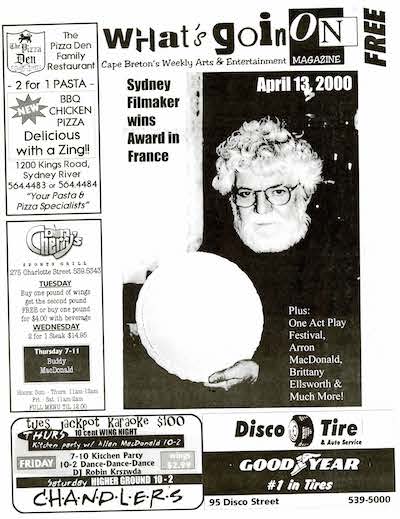
Wang Ling Rong Makes Another Pot, a short documentary by Sydney filmmaker Peyton Chisholm, was awarded the “Ceramics Prize: Clay In All Forms” during the KERAMOS: Films On Clay Festival held in Montpelier, France, over the first weekend of April.
The nine and a half minute film came out of a month trip to China that Chisholm made in 1998 with representatives from the Fortress Louisbourg. Part of the reason for the trip was to visit the facilities where reproductions of the porcelain used by the Fortress’s inhabitants were being manufactured.
The film documents in one uninterrupted take how potter Wang Ling Rong goes through the various steps needed to create a storage pot. Although, she does everything by hand, by the end of the video when she sets her new creation on the floor with dozens of identical pots, it is clear this is very much a mass produced artifact.
Chisholm says he found out about the KERAMOS festival after taking his film to a similar festival in Amsterdam, Holland, in the spring of 1999. He applied for entrance of his film into the Monteplier event, and it was chosen from over 130 films from over 24 countries to be one of 34 films shown in competition. With some financial assistance from the festival organizers and the Louisbourg Institute at the University College Of Cape Breton, he was able to travel to France with his film.
Chisholm says Monteplier is “just unbelievable. It’s a very old medieval city–a crusader’s city and a university city,” he says, describing the venue, “the old section of the city has narrow winding streets with large four story stone buildings, and no cars. It’s in the south of France and it has its own local made wine and cheese and lots of fresh seafood with oysters to die for.”
One of Chisholm’s goals in attending the festival was to find a French production company work with his company, Rolling Mill Film Co-operative, to produce a longer documentary on the porcelain being made for the Fortress of Louisbourg. The cities of Rochefort and Saint Rochelle, nearby to Monteplier, were, in centuries previous, the French port of entry for trade goods coming from China, a connection that might spark the interest of French filmmakers. Chisholm says he did make contact with a French filmmaker who had recently worked on a film in Bangladesh.
Chisholm’s film was screened in a 1000 seat auditorium with over 700 people there to view his work. He says, at the end of the piece, when Wang Ling Rong places her new pot with its dozens of mates, the audience broke out in thunderous applause. “It was an overwhelming feeling,” Chisholm says, “I knew they had caught the non-didactic concept behind the film.”
While sitting in the “realisteurs” row during the festival’s award ceremonies, Chisholm said, although one doesn’t feel one might win, just by being at the event there is an expectation that it could happen. But when they announced the award, Chisholm says, “With my broken French, I thought they had said my name. The room sort of went silent waiting for someone to jump up. The artistic director of the festival, Loul Combres, motioned to me to come down and I stumbled down to the stage.”
Appropriately, the prize itself is a hand made porcelain, made specifically for the festival by a French ceramic artist.
After the award presentation, Chisholm says, “all the groundwork we did in the first three days of the festival came together in 45 minutes. People I had wanted to meet, but couldn’t because of conflicting schedules, were coming up to congratulate me.” Chisholm made contacts with representatives of UNESCO, and with Canal +, a French arts and documentary channel. He also met with two filmmakers from Trois Riveres in Quebec who had also had a film in the festival and expressed interest in screening Chisholm’s film at festival to be held in their city in July.
Chisholm also signed a contract that would see his short film screened in festivals in Brazil, Italy, Taiwan, Germany, and possibly many other countries around the world. Imagine Ceramics is also selling Chisholm’s video in their chain of outlets around France and on its website.
Chisholm is eager to thank the many individuals and organizations that have assisted him in his efforts including the Louisbourg Institute at UCCB, Lisa Patterson at UCCB’s Multi-Media Education Centre who helped him edit the final product, and his colleagues at Rolling Mill.
To Chisholm, the success of his film at the KERAMOS festival proves Cape Bretoners have the skills and the talent to produce products that can compete in the global economy, and that, through international recognition and sales, these products will help support artists and industries on the island.
He observes, “In the 17th Century, porcelain came from China through France to Fortress Louisbourg on Cape Breton. Now a product from Cape Breton has gone through France to the world. As they might say in Monteplier, the world is our oyster.” (April 13, 2000)

